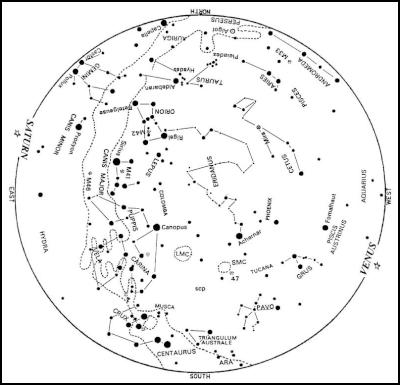The January Night Sky
Carter Observatory
The National Observatory of
New Zealand
THE NIGHT SKY
Brian Carter*
The Carter Observatory
wishes you all a wonderful holiday over the Christmas break
and hope that 2007 is good to you
all.
THE JANUARY NIGHT
SKY
Towards the end of the month we will
start to see the days getting shorter and, therefore, the
nights for astronomy,
longer.
Planets
January is a fairly good month for viewing the planets. Venus, Saturn, Jupiter and Mars will be visible for all of January. Only Mercury will be invisible during the month.
Venus will be visible in the evening twilight. At the start of the month it sets at 22 01 and at 21 50 by month’s end. Venus starts the month in the constellation of Sagittarius, moving into Capricornus on January 5 and finally into Aquarius on January 27. Its magnitude is a constant –3.9.
Saturn will be visible for all but the early
evening. At the start of January it rises at 23 16 and at 21
13 by month’s end. Saturn is in the constellation of Leo,
in which it remains until September 2009. Its magnitude
slightly brightens from 0.2 to 0.0 during the
month.
Jupiter will be visible for the
last third of the night in January. At the start of January
it rises at 03 45 and at 02 08 by month’s end. Jupiter is
in the constellation of Ophiuchus, in which it remains until
2007 December. Its magnitude slightly increases from –1.8
to –1.9 during the month.
Mars will
be visible in the morning sky. At the start of the month it
rises at 04 18 and at 03 53 by month’s end. Mars starts
the month in the constellation of Ophiuchus, moving into
Sagittarius on January 13. Its magnitude slightly increases
from 1.5 to 1.4 during the
month.
Mercury is visible too close to
the Sun to be seen in January. It will reappear in the
morning sky in March. Mercury starts the month in the
constellation of Sagittarius, moving into Capricornus on
January 15.
All times are for Wellington
unless otherwise stated. Other centres may vary by a few
minutes.
Phases of the
Moon
Full Moon – January 4 at 02 57.
Last Quarter
– January 12 at 01 45.
New Moon – January 19 at 17
01.
First Quarter – January 26 at 12
01.
Earth at
Perihelion
The Earth is at perihelion
(closest to the Sun) at 09:00 on January 4. The distance is
0.9832602 AU, which is 147,093,600 km.
Diary of Astronomical Phenomena
Jan
4 Full Moon at 02 57.
4 Earth at perihelion (closest to
the Sun) at 09:00. (Distance = 0.9832602 AU = 147,093,600
km).
7 Saturn close to the Moon in the morning
twilight.
7 Mercury in superior conjunction (on the far
side of the Sun) at 19 00.
11 Moon at apogee (furthest
from the Earth) at 05:00 (Distance = 0.0027028 AU = 404,330
km).
16 Antares close to the Moon as they both rise at
about 02 30.
19 New Moon at 17 01.
23 Moon at perigee
(closest to the Earth) at 02:00. (Distance = 0.0024527 AU =
366,920 km).
JANUARY SKY CHART
This chart
shows the sky as it appears at about 22:00 for ~January
15.

Click to enlarge
How To Use the Sky
Charts
To use the sky chart hold it up to the sky so
that the direction in which you are looking is at the lower
edge of the map. For example, if you are looking at the
western horizon then the map should be held so that the
“WEST” label is at the lower edge. The altitude and
direction of the stars and planets will then be correctly
shown. The centre of the chart will be directly
overhead.
* Brian Carter is the Senior Astronomer at Carter Observatory (The National Observatory of New Zealand), Observatory Web Site: www.CarterObservatory.org


 Binoy Kampmark: The Australian Defence Formula, Spend! Spend! Spend!
Binoy Kampmark: The Australian Defence Formula, Spend! Spend! Spend! Ian Powell: New Hospital Building Trumps ‘Yes Minister’ Hospital Without Patients
Ian Powell: New Hospital Building Trumps ‘Yes Minister’ Hospital Without Patients Mike Treen: Prices Are Still Rising - It's A Cost Of Living Crisis
Mike Treen: Prices Are Still Rising - It's A Cost Of Living Crisis Gordon Campbell: On When Racism Comes Disguised As Anti-racism
Gordon Campbell: On When Racism Comes Disguised As Anti-racism Peter Dunne: Newshub And TVNZ Tip Of Media Iceberg
Peter Dunne: Newshub And TVNZ Tip Of Media Iceberg Harry Finch: Austerity – For And Against
Harry Finch: Austerity – For And Against